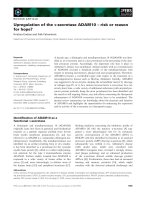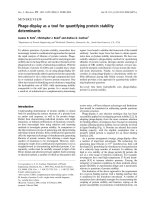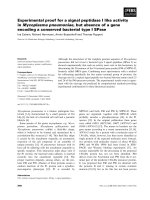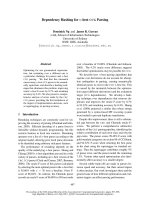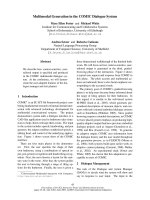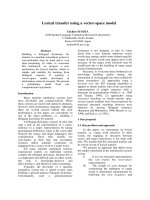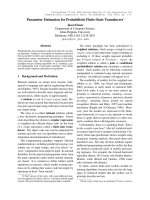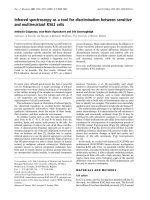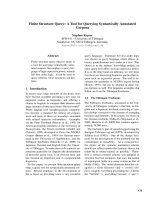Báo cáo khoa học: "Personalized Normalization for a Multilingual Chat System" doc
Bạn đang xem bản rút gọn của tài liệu. Xem và tải ngay bản đầy đủ của tài liệu tại đây (254.36 KB, 6 trang )
Proceedings of the 50th Annual Meeting of the Association for Computational Linguistics, pages 31–36,
Jeju, Republic of Korea, 8-14 July 2012.
c
2012 Association for Computational Linguistics
Personalized Normalization for a Multilingual Chat System
Ai Ti Aw and Lian Hau Lee
Human Language Technology
Institute for Infocomm Research
1 Fusionopolis Way, #21-01 Connexis, Singapore 138632
Abstract
This paper describes the personalized
normalization of a multilingual chat system that
supports chatting in user defined short-forms or
abbreviations. One of the major challenges for
multilingual chat realized through machine
translation technology is the normalization of
non-standard, self-created short-forms in the
chat message to standard words before
translation. Due to the lack of training data and
the variations of short-forms used among
different social communities, it is hard to
normalize and translate chat messages if user
uses vocabularies outside the training data and
create short-forms freely. We develop a
personalized chat normalizer for English and
integrate it with a multilingual chat system,
allowing user to create and use personalized
short-forms in multilingual chat.
1 Introduction
Processing user-generated textual content on social
media and networking usually encounters
challenges due to the language used by the online
community. Though some jargons of the online
language has made their way into the standard
dictionary, a large portion of the abbreviations,
slang and context specific terms are still
uncommon and only understood within the user
community. Consequently, content analysis or
translation techniques developed for a more formal
genre like news or even conversations cannot
apply directly and effectively to the social media
content. In recent years, there are many works (Aw
et al., 2006; Cook et al., 2009; Han et al., 2011) on
text normalization to preprocess user generated
content such as tweets and short messages before
further processing. The approaches include
supervised or unsupervised methods based on
morphological and phonetic variations. However,
most of the multilingual chat systems on the
Internet have not yet integrated this feature into
their systems but requesting users to type in proper
language so as to have good translation. This is
because the current techniques are not robust
enough to model the different characteristics
featured in the social media content. Most of the
techniques are developed based on observations
and assumptions made on certain datasets. It is also
difficult to unify the language uniqueness among
different users into a single model.
We propose a practical and effective method,
exploiting a personalized dictionary for each user,
to support the use of user-defined short-forms in a
multilingual chat system - AsiaSpik. The use of this
personalized dictionary reduces the reliance on the
availability and dependency of training data and
empowers the users with the flexibility and
interactivity to include and manage their own
vocabularies during chat.
2 ASIASPIK System Overview
AsiaSpik is a web-based multilingual instant
messaging system that enables online chats written
in one language to be readable in other languages
by other users. Figure 1 describes the system
process. It describes the process flow between
Chat Client, Chat Server, Translation Bot and
Normalization Bot whenever Chat Client starts
chat module.
When Chat Client starts chat module, the Chat
Client checks if the normalization option for that
language used by the user is active and activated. If
31
so, any message sent by the user will be routed to
the Normalization Bot for normalization before
reaching the Chat Server. The Chat Server then
directs the message to the designated recipients.
Chat Client at each recipient invokes a translation
request to the Translation Bot to translate the
message to the language set by the recipient. This
allows the same source message to be received by
different recipients in different target languages.
Figure 1. AsiaSpik Chat Process Flow
In this system, we use Openfire Chat Server by
Ignite Realtime as our Chat Server. We custom
build a web-based Chat Client to communicate
with the Chat Server based on Jabber/XMPP to
receive presence and messaging information. We
also develop a user management plug-in to
synchronize and authenticate user login. The
translation and normalization function used by the
Translation Bot and Normalization Bot are
provided through Web Services.
The Translation Web Service uses in-house
translation engines and supports the translation
from Chinese, Malay and Indonesian to English
and vice versa. Multilingual chat among these
languages is achieved through pivot translation
using English as the pivot language. The
Normalization Web Service supports only English
normalization. Both web services are running on
Apache Tomcat web server with Apache Axis2.
3 Personalized Normalization
Personalized Normalization is the main distinction
of AsiaSpik among other multilingual chat system.
It gives the flexibility for user to personalize
his/her short-forms for messages in English.
3.1 Related Work
The traditional text normalization strategy follows
the noisy channel model (Shannon, 1948). Suppose
the chat message is
C and its corresponding
standard form is
S
, the approach aims to find
)|(maxarg CSP by computing
)|(maxarg SCP
in which
)(SP
is usually a
language model and
)|( SCP is an error model.
The objective of using model in the chat message
normalization context is to develop an appropriate
error model for converting the non-standard and
unconventional words found in chat messages into
standard words.
)()|(maxarg)|(maxarg
^
SPSCPCSPS
S
S
Recently, Aw et al. (2006) model text message
normalization as translation from the texting
language into the standard language. Choudhury et
al. (2007) model the word-level text generation
process for SMS messages, by considering
graphemic/phonetic abbreviations and
unintentional typos as hidden Markov model
(HMM) state transitions and emissions,
respectively. Cook and Stevenson (2009) expand
the error model by introducing inference from
different erroneous formation processes, according
to the sample error distribution. Han and Baldwin
(2011) use a classifier to detect ill-formed words,
and generate correction candidates based on
morphophonemic similarity. These models are
effective on their experiments conducted, however,
much works remain to be done to handle the
diversity and dynamic of content and fast evolution
of words used in social media and networking.
As we notice that unlike spelling errors which
are made mostly unintentionally by the writers,
abbreviations or slangs found in chat messages are
introduced intentionally by the senders most of the
time. This leads us to suggest that if facilities are
given to users to define their abbreviations, the
dynamic of the social content and the fast
32
evolution of words could be well captured and
managed by the user. In this way, the
normalization model could be evolved together
with the social media language and chat message
could also be personalized for each user
dynamically and interactively.
3.2 Personalized Normalization Model
We employ a simple but effective approach for
chat normalization. We express normalization
using a probabilistic model as below
)|(maxarg csPs
s
best
and define the probability using a linear
combination of features
),(exp)|(
1
cshcsP
k
m
k
k
where
),( csh
k
are two feature functions namely
the log probability
)|(
, iji
csP
of a short-form,
i
c
,
being normalized to a standard form,
ji
s
,
; and the
language model log probability.
k
are weights of
the feature functions.
We define
)|(
, iji
csP
as a uniform distribution
computed through a set of dictionary collected
from corpus, SMS messages and Internet sources.
A total of 11,119 entries are collected and each
entry is assigned with an initial probability,
||
1
)|(
,
i
ijis
c
csP
, where
||
i
c
is the number of
i
c
entries defined in the dictionary. We adjust the
probability manually for some entries that are very
common and occur more than a certain threshold,
t
, in the NUS SMS corpus (How and Kan, 2005)
with a higher weight-age,
w . This model, together
with the language model, forms our baseline
system for chat normalization.
|),(| if
|),(|
|),(|
||
1
|),(| if
||
1
)|(
,
,
,
,
,
tcs
tcs
tcsw
c
tcsw
c
csP
iji
iji
iji
i
iji
i
ijis
To enable personalized real-time management
of user-defined abbreviations and short-forms, we
define a personalized model
)|(
,_ ijiiuser
csP
for
each user based on his/her dictionary profile. Each
personalized model is loaded into the memory
once the user activates the normalization option.
Whenever there is a change in the entry, the entry’s
probability will be re-distributed and updated
based on the following model. This characterizes
the AsiaSpik system which supports personalized
and dynamic chat normalization.
SD if
M
1
SD , SD if
1
S ,c if )|(
)|(
,
, i,
,_
i
jii
jiijis
ijiiuser
c
sc
MN
Ds
MN
N
csP
csP
.dictionaryin user entries of number thedenotes M
SDin entries of number thedenotesN
;dictionarydefault denotes SD
where
i
i
c
c
The feature weights in the normalization model
are optimized by minimum error rate training
(Och, 2003), which searches for weights
maximizing the normalization accuracy using a
small development set. We use standard state-of-
the-art open source tools, Moses (Koehn, 2007), to
develop the system and the SRI language modeling
toolkit (Stolcke,2003) to train a trigram language
model on the English portion of the Europarl
Corpus (Koehn, 2005).
3.3 Experiments
We conducted a small experiment using 134 chat
messages sent by high school students. Out of
these messages, 73 short-forms are uncommon and
not found in our default dictionary. Most of these
33
short-forms are very irregular and hard to predict
their standard forms using morphological and
phonetic similarity. It is also hard to train a
statistical model if training data is not available.
We asked the students to define their personal
abbreviations in the system and run through the
system with and without the user dictionary. We
asked them to give a score of 1 if the output is
acceptable to them as proper English, otherwise a 0
will be given. We compared the results using both
the baseline model and the model implemented
using the same training data as in Aw et al. (2006).
Table 1 shows the number of accepted output
between the two models. Both models show
improvement with the use of user dictionary. It
also shows that it is very critical to have similar
training data for the targeted domain to have good
normalization performance. A simple model helps
if such training data is unavailable. Nevertheless,
the use of a dictionary driven by the user is an
alternative to improve the overall performance.
One reason for the inability of both models to
capture the variations fully is because many
messages require some degree of rephrasing in
addition to insertion and deletion to make it
readable and acceptable. For example, the ideal
output for “haiz, I wanna pontang school” is “Sigh,
I do not feel like going to school”, which may not
be just a normalization problem.
Baseline
Model
Baseline +
User
Dictionary
Aw et al.
(2006)
Aw et al.
(2006) +
user
Dictionary
40 72 17 42
Table 1. Number of Correct Normalization Output
In the examples showed in Table 2, ‘din’ and
‘dnr’ are normalized to ‘didn’t’ and ‘do not reply’
based on the entries captured in the default
dictionary. With the extension of normalization
hypotheses in the user dictionary, the system
produces the correct expansion to ‘dinner’.
Chat Message Chat Message
normalized
using the
Default
dictionary
Chat Message
normalized
with the
supplement of
user dictionary
buy din 4
urself.
Buy didn't for
yourself.
Buy dinner for
yourself.
dun cook dnr 4
me 2nite
Don't cook do
not reply for me
tonight
Don't cook
dinner for me
tonight
gtg bb ttyl ttfn Got to go bb ttyl
ttfn
Got to go bye
talk to you later
bye bye
I dun feel lyk
riting
I don't feel lyk
riting
I don't feel like
writing
im gng hme 2
mug
I'm going hme
two mug
I'm going home
to study
msg me wh u
rch
Message me wh
you rch
Message me
when you reach
so sian I dun
wanna do hw
now
So sian I don't
want to do how
now
So bored I don't
want to do
homework now
Table 2. Normalized chat messages
AsiaSpik Multilingual Chat
Figure 2 and Figure 3 show the personal lingo
defined by two users. Note that expansions for
“gtg” and “tgt” are defined differently and
expanded differently for the two users. ‘Me’ in the
message box indicates the message typed by the
user while ‘Expansion’ is the message expanded
by the system.
Figure 2. Short-forms defined and messages
expanded for user 1
34
Figure 3. Short-forms defined and messages
expanded for user 2
Figure 4 shows the multilingual chat exchange
between a Malay language user (Mahani) and an
English user (Keith). The figure shows the
messages are first expanded to the correct forms
before translated to the recipient language.
Figure 4. Conversion between a Malay user & an
English user
4 Conclusions
AsiaSpik system provides an architecture for
performing chat normalization for each user such
that user can chat as usual and does not need to pay
special attention to type in proper language when
involving translation for multilingual chat. The
system aims to overcome the limitations of
normalizing social media content universally
through a personalized normalization model. The
proposed strategy makes user the active contributor
in defining the chat language and enables the
system to model the user chat language
dynamically.
The normalization approach is a simple
probabilistic model making use of the
normalization probability defined for each short-
form and the language model probability. The
model can be further improved by fine-tuning the
normalization probability and incorporate other
feature functions. The baseline model can also be
further improved with more sophisticated method
without changing the architecture of the full
system.
AsiaSpik is a demonstration system. We would
like to expand the normalization model to include
more features and support other languages such as
Malay and Chinese. We would also like to further
enhance the system to convert the translated
English chat messages back to the social media
language as defined by the user.
References
AiTi Aw, Min Zhang, Juan Xiao, and Jian Su. 2006. A
Phrase-based statistical model for SMS text
normalization. In Proc. Of the COLING/ACL 2006
Main Conference Poster Sessions, pages 33-40.
Sydney.
Monojit Choudhury, Rahul Saraf, Vijit Jain, Animesh
Mukherjee, Sudeshna Sarkar, and Anupam Basu.
2007. Investigation and modeling of the structure of
texting language. International Journal on Document
Analysis and Recognition, 10:157–174.
Paul Cook and Suzanne Stevenson. 2009. An
unsupervised model for text message normalization.
In CALC ’09: Proceedings of the Workshop on
Computational Approaches to Linguistic Creativity,
pages 71–78, Boulder, USA.
Bo Han and Timothy Baldwin. 2011. Leixcal
Normalisation of Short Text Messages: Makn Sens a
#twitter. In Proc. Of the 49
th
Annual Meeting of the
Association for Computational Linguistics, pages
368-378, Portland, Oregon, USA.
Yijue How and Min-Yen Kan. 2005. Optimizing
predictive text entry for short message service on
mobile phones. In Proceedings of HCII.
Philipp Koehn &al. Moses: Open Source Toolkit for
Statistical Machine Translation, ACL 2007,
demonstration session.
Koehn, P. (2005). Europarl: A Parallel Corpus for
Statistical Machine Translation. In Machine
Translation Summit X (pp. 79{86). Phuket, Thailand.
Franz Josef Och. 2003. Minimum error rate training for
statistical machine translation. In Proceedings of the
35
41th Annual Meeting of the Association for
Computational Linguistics, Sapporo, July.
C. Shannon. 1948. A mathematical theory of
communication. Bell System Technical Journal
27(3): 379-423
A. Stolcke. 2003 SRILM – an Extensible Language
Modeling Toolkit. In International Conference on
Spoken Language Processing, Denver, USA.
36
